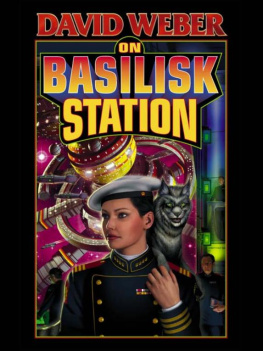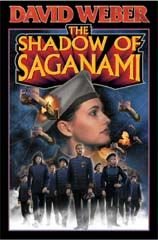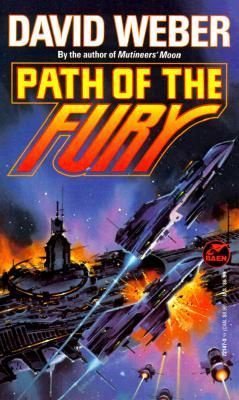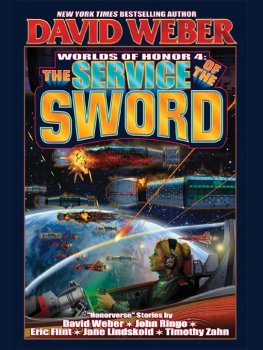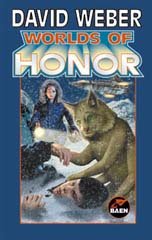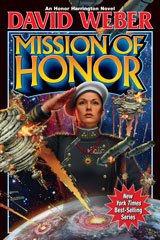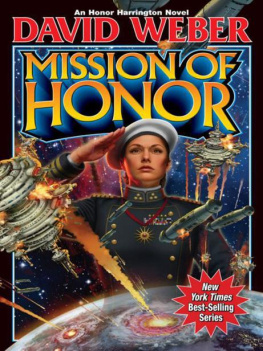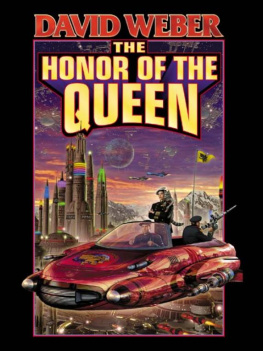David Weber - The Universe of Honor Harrington
Here you can read online David Weber - The Universe of Honor Harrington full text of the book (entire story) in english for free. Download pdf and epub, get meaning, cover and reviews about this ebook. genre: Science fiction. Description of the work, (preface) as well as reviews are available. Best literature library LitArk.com created for fans of good reading and offers a wide selection of genres:
Romance novel
Science fiction
Adventure
Detective
Science
History
Home and family
Prose
Art
Politics
Computer
Non-fiction
Religion
Business
Children
Humor
Choose a favorite category and find really read worthwhile books. Enjoy immersion in the world of imagination, feel the emotions of the characters or learn something new for yourself, make an fascinating discovery.
- Book:The Universe of Honor Harrington
- Author:
- Genre:
- Rating:5 / 5
- Favourites:Add to favourites
- Your mark:
- 100
- 1
- 2
- 3
- 4
- 5
The Universe of Honor Harrington: summary, description and annotation
We offer to read an annotation, description, summary or preface (depends on what the author of the book "The Universe of Honor Harrington" wrote himself). If you haven't found the necessary information about the book — write in the comments, we will try to find it.
The Universe of Honor Harrington — read online for free the complete book (whole text) full work
Below is the text of the book, divided by pages. System saving the place of the last page read, allows you to conveniently read the book "The Universe of Honor Harrington" online for free, without having to search again every time where you left off. Put a bookmark, and you can go to the page where you finished reading at any time.
Font size:
Interval:
Bookmark:
David Weber
The Universe of Honor Harrington
Honor Harrington was born on October 1, 1859 Post Diaspora, at Craggy Hollow (the Harrington family homestead), County Duvalier, in the Duchy of Shadow Vale, Sphinx. In general, one might say that she was born at the twilight of what had been a long, relatively stable and peaceful period of galactic history. Her native Star Kingdom of Manticore was widely respected as one of the wealthiest star nations in existence (probably the wealthiest, on a per capita basis), and its carrying trade dominated the interstellar freight lines outside the Solarian League itself. The galaxy had not seen a major war in over a century, although there were always places (like the Silesian Confederacy) where ongoing low-level conflicts were the norm rather than the exception. Aside from rumblings out of the economically devastated People's Republic of Haven, which had recently forcibly annexed a half dozen neighboring systems, there seemed little reason to expect that to change.
But by 1901 pd, (the time of On Basilisk Station ) it had changed, and changed drastically. The PRH's steady economic collapse had driven its expansionism to heights unseen since pre-space days on Old Terra, and the Star Kingdom of Manticore lay squarely in the Peeps' path. The last century's "golden age" was coming to an end with the approach of an interstellar war which would, before it ended, see virtually the entire human-occupied galaxy choosing up sides, with military operations on a scale no one had ever previously contemplated.
This appendix sketches in some of the salient points of the galaxy into which Honor was born and which she, willingly or not, was to play a major part in changing forever.
(1) Background (General)
The first manned interstellar ship departed the Solar System on September 30, 2103. Although no other ship followed for almost fifty years, 2013 ce, became accepted as Year One of the Diaspora, and January 1 of that year became January 1, 01 pd for purposes of interstellar dating.
For over seven centuries after the Prometheus became the first manned starship, FTL movement remained impossible, leaving generation ships (followed in the fourth century pd by the development of practical cryogenic hibernation vessels) as the only means of long-distance interstellar expansion. The original starships used fairly straightforward reaction drives with hydrogen catcher fields to sustain boost after the initial onboard reaction mass was exhausted. Later generations attempted more esoteric propulsion systems, but though they graduated to fusion and photon drives, they remained locked into the sublight reaction principle until 725 pd, when the first crude hyper drive was tested in the Solar System.
The interface between normal and hyper-space was speed-critical, for if velocity at hyper translation exceeded .3 c, the translating starship was destroyed. In addition, a hypership had to reach the hyper limit of a star's gravity well before it could enter hyper, and the hyper limit varies with the spectral class of the star, as shown in Figure 1.
The original hyper drive was a man-killer. The casualty figures over the first fifty years of hyper travel were daunting. Worse, vessels which were destroyed were lost with all hands, which left no record of their fates and thus offered no clue as to the causes of their destruction. Eventually, however, it was determined that most had probably been lost to one of two phenomena, which became known as "grav shear" (see below) and "dimensional shear" (violent energy turbulence separating hyper bands from one another). Once this was recognized and the higher hyper bands were declared off limits, losses due to dimensional shear ended, but grav shear remained a highly dangerous and essentially unpredictable phenomenon for the next five centuries. Despite that unpredictability and continuing (though lower) loss rates, hyperships' FTL capabilities made them the vessel of choice for survey duties and other low-manpower requirement tasks. Crews of highly paid specialists willing to accept risky employment conditions were enlisted for survey work and for the early mail packets, but the loss rate continued to make any sort of interstellar bulk commerce impractical and insured that most colonists still moved aboard the much slower but more survivable cryogenic ships. As a consequence, the rate of advance of colonization did not increase terribly significantly during the period 725-1273 pd, although the ability to pick suitable targets for colonization (courtesy of the FTL survey crews) improved enormously.
The best speed possible in hyper prior to 1273 pd was about fifty times light-speed, a major plus over light-speed vessels but still too slow to tie distant stars together into any sort of interstellar community. It was sufficient to allow establishment of the oldest of the currently existing interstellar polities, the Solarian League, consisting of the oldest colony worlds within approximately ninety light-years of Sol.
The major problem limiting hyper speeds was that simply getting into hyper did not create a propulsive effect. Indeed, the initial translation into hyper was a complex energy transfer which reduced a starship's velocity by "bleeding off" momentum. In effect, a translating hypership lost approximately 92% of its normal-space velocity when entering hyper. This had unfortunate consequences in terms of reaction mass requirements, particularly since the fact that hydrogen catcher fields were inoperable in hyper meant one could not replenish one's reaction mass underway. On the other hand, the velocity bleed effect applied equally regardless of the direction of the translation (that is, one lost 92% of one's velocity whether one was entering hyper-space from normal-space or normal-space from hyper-space), which meant that leaving hyper automatically decelerated one's vessel to a normal-space velocity only 08% of whatever its velocity had been in hyper-space. This tremendously reduced the amount of deceleration required at the far end of a hyper voyage and so made reaction drives at least workable.
Since .3 c (approx. 89,907.6 km./sec.) was the maximum velocity at which an "upward" translation into hyper-space could be made, the maximum initial velocity in hyper-space was .024 c (or 7,192.6 km./sec.). Making translation at speeds as high as .3 c was a rough experience and not particularly safe. The loss rate at .3 c was over 10%; dropping translation velocity to .23 c virtually eliminated ship losses in initial translation, and, since the difference in initial hyper velocity was less than 1,700 KPS, most captains routinely made translation at the lower speed. Even today, only military commanders in emergency conditions will make upward translation at .3 c. There is no safe upper speed on "downward" translations. That is, a ship may translate from hyper-space to normal-space at any hyper-space velocity without risking destruction. (Which is not to say that the crews enjoy the experience or that it does not impose enormous wear and tear on hyper generators.) Further, translation from one hyper band to a higher band (see below) may be made at any velocity up to and including .6 c. No vessel may exceed .6 c in hyper (.8 in normal-space) because radiation and particle shields cannot protect them or their passengers at higher velocities.
Once a vessel enters hyper, it is placed in what might be considered a compressed dimension which corresponds on a point-by-point basis to "normal-space" but places those points in much closer congruity. Hyper-space consists of multiple regions or layers called "bands" of associated but discrete dimensions. Dr. Radhakrishnan (who, after Adrienne Warshawski, is considered to have been humanity's greatest hyper-physicist) called the hyper bands "the back-flash of creation," for they might be considered echoes of normal-space, the consequence of the ultimate convergence of the mass of an entire normal-space universe. Or, as Dr. Warshawski once put it, "Gravity folds normal-space everywhere, by however small an amount, and hyper-space may be considered the 'inside' of all those little folds."
Font size:
Interval:
Bookmark:
Similar books «The Universe of Honor Harrington»
Look at similar books to The Universe of Honor Harrington. We have selected literature similar in name and meaning in the hope of providing readers with more options to find new, interesting, not yet read works.
Discussion, reviews of the book The Universe of Honor Harrington and just readers' own opinions. Leave your comments, write what you think about the work, its meaning or the main characters. Specify what exactly you liked and what you didn't like, and why you think so.



